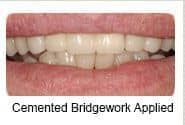What is a cemented dental bridge?

A cemented bridge is a way to replace one or more missing teeth to help restore function and/or aesthetics. A cemented bridge generally requires at least one tooth on either side of the missing tooth or teeth to provide the attachment and support for the bridge. First, the teeth on either side of the missing tooth or teeth are prepared for crowns. A dental laboratory then creates a bridge out of one of three materials: porcelain fused to a cast metal framework, porcelain fused to a tooth-colored framework, or a full gold bridge. The teeth with the crowns serve as “abutments” to the bridge, and the missing teeth that occupy the space between the abutments are called pontics. The bridge connects all of the teeth, abutments and pontics.

A bridge is beneficial because it restores function and aesthetics where needed. The loss of a tooth can cause a number of problems, including loss of chewing effectiveness, increased stress on the remaining teeth to “pick up the slack,” shifting of the teeth behind and above the tooth which is lost, leaving other teeth non-functional and continuing the cycle. And lost front teeth pose an aesthetic dilemma for most people.
A cemented bridge is typically made in two visits, the first being the preparation appointment and the second the bridge insertion.
Teeth replacement options
When a tooth is lost, there are generally three options for replacement: a cemented dental bridge, a dental implant, or a removable bridge/partial denture. The restoration generally compared to a cemented bridge is the dental implant because both of these restorations are fixed in place. Implants are becoming the restoration of choice in dentistry for a missing tooth for a variety of reasons, mainly associated with the fact that the teeth next to the missing tooth or teeth do not have to prepared or “shaved down” to make room for the crowns. The following compares a typical three tooth cemented bridge replacing one tooth to a single tooth implant:
| Cemented Bridge | Three unit bridge | Single tooth implant |
|---|---|---|
| Success Rate | 50% need to be redone within 10 years | 97% or higher |
| Decay Rate | Most common cause for remakes | 0% |
| Root Canal Rate | 20% of abutments need root canals | 0% |
| Can Be Performed for Missing Back Teeth | No | Yes |
| Preserves Bone in Area of Missing Tooth | No | Yes |
The Manhattan Dentist, Dr. Binder will consult with you to help you determine the restoration which is best for you.